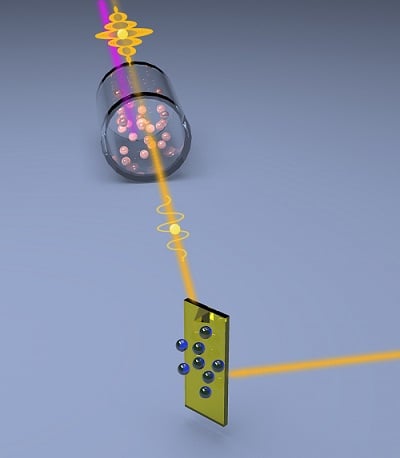Researchers at the U.S. Department of Energy’s Oak Ridge National Laboratory (ORNL) used quantum optics to advance state-of-the-art microscopy and, in doing so, chart a a path to detecting material properties with greater sensitivity than is possible with traditional tools.
The quantum microscope uses nonlinear amplifiers to generate a special quantum light source known as squeezed light.
“We showed how to use squeezed light — a workhorse of quantum information science — as a practical resource for microscopy,” said Ben Lawrie of ORNL’s Materials Science and Technology Division, who led the research with Raphael Pooser of ORNL’s Computational Sciences and Engineering Division. “We measured the displacement of an atomic force microscope microcantilever with sensitivity better than the standard quantum limit.”
Squeezed light is able reveal finer details than classical noisy light, and it can be used instead of a laser to reduce the noise in the sensor readout, Pooser said.

ORNL researchers developed a quantum, or squeezed, light approach for atomic force microscopy that enables measurement of signals otherwise buried by noise. Courtesy of Raphael Pooser, ORNL, U.S. Department of Energy.
The researchers showed that their quantum microscope was capable of measuring the displacement of a microcantilever with 50% better sensitivity than is classically possible. The cantilever in the system is 450 × 50 µm in cross-section, Lawrie said. For one-second-long measurements, the quantum-enhanced sensitivity was 1.7 femtometers, which is approximately twice the diameter of a carbon nucleus.
The researchers employed nonlinear interferometry to increase the sensitivity and reduce noise.
“A conventional linear interferometer typically relies on a pair of 50/50 beamsplitters,” Lawrie said. “Nonlinear interferometers (NLIs) replace those beamsplitters with nonlinear amplifiers, effectively creating an interferometer where each beamsplitter has some gain.”
A prototypical nonlinear interfereometer uses one phase insensitive nonlinear amplifier to generate signal and idler fields and then recombines them in a phase-sensitive nonlinear amplifier in order to read out changes in the phase of the signal or idler field, he said.
“In our experiment we used only a single nonlinear amplifier, a four-wave mixing source in a rubidium-85 vapor cell,” Lawrie said. “That source generates a two-mode squeezed state that exhibits quantum noise reduction below the photon shot noise limit. We then used dual homodyne detection instead of a phase sensitive nonlinear amplifier to read out the change in phase induced by a microcantilever on one channel of the two mode squeezed state.”
Paul Lett’s group at NIST dubbed the approach “truncated nonlinear interferometry” because it offers similar sensitivity scaling to a conventional nonlinear interferometer.
“Squeezed states are fragile quantum states,” Pooser said. “In this experiment, we were able to circumvent the problem by exploiting properties of entanglement. Because of entanglement, if we measure the power of one beam of light, it would allow us to predict the power of the other one without measuring it. Because of entanglement, these measurements are less noisy, and that provides us with a higher signal-to-noise ratio.”
This technique could have applications in biochemical sensing, dark matter detection, or the characterization of magnetic properties of materials, Lawrie said.
The research was published in Physical Review Letters (www.doi.org/10.1103/PhysRevLett.124.230504).